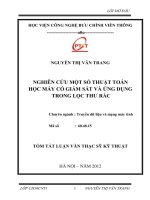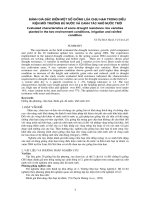Một số cân nhắc về Bioindicators trong Giám sát môi trường
Bạn đang xem bản rút gọn của tài liệu. Xem và tải ngay bản đầy đủ của tài liệu tại đây (512.69 KB, 11 trang )
Polish Journal of Environmental Studies Vol. 13, No. 5 (2004), 453-462
Review
Some Considerations About Bioindicators in
Environmental Monitoring
R. Gadzała-Kopciuch
1
, B. Berecka
2
, J. Bartoszewicz
2
, B. Buszewski
1
Department of Environmental Chemistry and Ecoanalytics, Faculty of Chemistry,
Nicolaus Copernicus University, 7 Gagarin St, 87-100 Toruń, Poland
2
Department of Chemistry, Faculty of Environmental Management and Agriculture, University of Warmia and
Mazury, Pl. Łódzki 4, 10-719 Olsztyn, Poland
Received: 10 January 2004
Accepted: 3 April 2004
Abstract
Toxic chemicals introduced into the environment can penetrate ecosystems and can be found in the
whole biosphere. Chemical contamination may affect ecosystems, causing changes in the functions of
particular organisms. Adverse effects of xenobiotics and their metabolites on living organisms can be
observed. In the last few years investigations have focused on searching for bioindicators (both plant and
animal organisms) that accumulate toxic substances. The aim of the present study was to discuss selected
methods of environmental quality assessment based on living organisms used as bioindicators, paying
special attention to water ecosystems.
Keywords: biomonitoring, bioindicators, xenobiotics, environment
Introduction
Growing social concern about environmental qual-
ity could be observed in recent years, both on a global
and local scale. This is connected with more and more
convincing evidence that environmental pollution results
in degradation of particular ecosystems. Emission of
harmful substances has negative effects on the natural
environment, human health and agricultural production
efficiency. When the consequences of environmental
pollution become visible, it is often too late to prevent
them. Chronic toxic effects, impossible to notice at the
initial stage of the process, may manifest themselves after
many years [1].
Toxic chemical substances introduced into the envi-
ronment may be transported by the air, water and living
organisms (Figure 1). These substances can be found in
the whole biosphere. They become a part of the natural
biogeochemical cycle and accumulate in the food chain.
*Corresponding author; e-mail: r
They also affect humans, causing (directly or indirectly)
various poisonings, toxicoses, and even neoplastic diseas-
es. Water constitutes the “trouble spot” of all
ecosystems, as many pollutants are waterborne [2]. It
also plays an important role as a solvent of various
substances, and as a medium in the cycle: air-soil-plants-
animals.
Due to constant technological progress the natural
environment undergoes numerous changes, deteriorating
its quality, which often results in negative interactions
between particular ecosystem components. During the
biological evolution living organisms needed complex
defense and adaptation mechanisms to survive under
changing environmental conditions. Most of them man-
aged to adapt to specific environments, but when their
adaptability threshold is crossed they die [3].
Environmental toxicology deals with toxic substances,
their adverse effects on living organisms, and
environmen- tal pollution assessment. Chemical
contamination may affect ecosystems, causing changes in
the functions of particular organisms or modifying the
physical properties of the environment. The relationships
between the xenobi-
454
Gadzała-Kopciuch R. et al
2 2
otic, environment and organism may, under certain condi-
tions, result in the degradation of toxic compounds
through their modification, inducing changes in the
environment and producing a negative effect on living
organisms [3].
Xenobiotics may penetrate into the organisms via air,
water, soil, dust and food, through the skin, respiratory
system and alimentary tract. Some chemical substances
showing strong toxic properties may cause local cellular
damage, but in the majority of cases their effects can be
observed when they penetrate into the circulatory system,
undergo metabolism and accumulate in various organs
(some of their metabolites may be excreted). The num-
ber of xenobiotics released into the environment is still
growing, which is very dangerous as they can modify the
functions of the endocrine, reproductive, nervous and im-
mune system. New compounds often undergo changes,
and their metabolism is very slow due to the lack of
previous contacts of the organism with such substances.
The aim of the present study was to discuss selected
methods of environmental quality assessment based on
living organisms used as bioindicators, paying special
attention to water ecosystems.
General Characteristics of Xenobiotics
Humans are more and more frequently exposed to
the effects of exogenous compounds – xenobiotics (gr.
xenos – alien), e.g. food preservatives or environmental
pollutants. Most xenobiotics undergo changes in the hu-
man organism, mainly in the liver (very seldom are they
excreted in an unchanged form). These reactions may be
divided into two phases. The main reaction in the first
phase (equation 1) is hydroxylation catalyzed by one
of the enzymes classified as monooxygenases or cyto-
chromes P-450.
The degree of exposure depends, among other things,
on their concentration in a given ecosystem, stability,
RH + O + NADPH + H → R – OH + H O + NADP (1)
rate of migration and potential bioaccumulation. The
information on the effects of these substances on human
health is scant, so it is difficult to estimate the degree of
risk they pose. Only about 10% of commercial chemical
compounds have been tested for their carconogenesis,
mutagenesis and reproduction-related toxicity [4]. It is
estimated that since the beginning of mankind about six
million chemical compounds have been produced, most
of them in the 20
th
century, and still over a thousand are
introduced each year [1].
Environmental pollution constitutes a serious threat to
the existence of ecosystems. It follows that
environmental monitoring must become a constant
element of pollution control and prediction on a local
scale. Environmental monitoring is a an integral part of
international projects implemented within the 6
th
Framework Program financed by the European Union.
Particular attention is paid to the identification of
xenobiotics and their metabolites. An- other aim of the
projects is to determine the changes they may undergo in
the environment, thus posing a threat to the functioning
of living organisms, and especially to hu- man health and
life.
�
�
�
�
�
� �
�
� �
� �
�
� �
� �
�
� �
�
� �
where: RH – xenobiotic.
Reduction and hydrolysis may also take place in this
phase. The compounds formed in the next phase are
trans- formed to various metabolites by specific enzymes.
Typi- cal reactions are: a coupling reaction (e.g. with
glucuronic acid, sulfuric acid, acetic acid, glutathione or
amino acids) or methylation [5]. The main aim of both
phases of xeno- biotic transformation is to increase their
water solubility (polarity), which makes it easier to
excrete them from the organism. Getting to know the
mechanism of action of such compounds at the cellular
level provides the basis for preventing a chemical attack
against living organisms [6, 7].
Much attention has been paid recently to the problem
of environmental pollution with chemical compounds
characterized by estrogenic properties, present in lakes,
rivers, oceans, crops and food products of animal ori-
gin. Exposure to these compounds, especially at early
stages of intrauterine life, may produce permanent and
irreversible effects. Estrogenic activity is typical of poly-
chlorinated biphenyls (PCBs), dioxins, plant protection
chemicals, e.g. DDT (dichlorophenyl-trichloroethane),
drugs administered in heart diseases, nephropathy, hepa-
topathy and inflammation of reproductive organs [8-10].
Some of them may also show mutagenic and
carcinogenic effects [11].
�
�
�
� �
�
�
� �
� �
�
�
�
�
�
�
�
�
�
�
� �
�
�
�
�
�
�
�
�
�
�
�
� �
�
�
�
�
�
�
�
�
�
�
�
�
�
� �
� �
�
�
�
�
�
�
�
�
�
�
�
�
�
�
�
�
�
�
�
� �
�
�
�
�
�
�
�
��
�
�
�
� �
� �
�
�
�
� �
�
�
� �
�
�
�
�
� �
�
�
�
�
�
�
� �
�
�
� �
�
� �
�
�
� � �
�
�
�
�
�
�
�
� �
�
�
�
�
�
�
�
� �
� �
�
� �
�
�
�
�
� � � �
�
�
�
�
�
�
�
�
��
� � �
�
�
�
�
�
�
�
�
�
�
�
�
�
�
�
� �
� �
�
�
� �
�
�
�
�
� �
�
��
�
Many animal populations have already experienced
the effects of xenoestrogens, which manifested them-
selves in reduced fertility of birds, fish, crustaceans and
mammals. Some bird species inhabiting the Great Lakes
(North America) lose their reproductive power as a result
of fish contamination (their main source of nourishment).
Also, fertility disturbances, testiculoma, prostatic hyper-
trophy, sexual development disorders, disturbances of
thyroid and hypophysis functions and reduced immunity,
observed in recent years in men, are connected with the
454
Gadzała-Kopciuch R. et alG
Fig. 1. Circulation of xenobiotics in the environment [3].
presence of xenoestrogens in the natural environment.
Some Considerations About Bioindicators..
4554
However, specialists differ in their opinions on the
effects of xenoestrogens – some authors even think that
the prob- lem of environmental estrogens does not exist
[12].
An example may be polychlorinated biphenyls
(PCBs), which due to their specific physicochemical
properties have been widely applied to heat engineering,
hydraulics, and the plastics industry. However, due to
their high chemical stability, they are present in the envi-
ronment. A natural consequence of their affinity for fats
is the accumulation of these substances in the organism,
resulting from their active uptake from the environment
(e.g. water, air, food), combined with biological concen-
tration increase in the trophic pyramid (Table 1). Their
toxic effects result from disturbances in the endocrine
system in humans and animals. Hormonally active xe-
nobiotics can disturb the endocrine functions of the male
gonad, because they affect hormone synthesis, storage,
secretion, transportation and release, as well as binding to
the receptor. The mechanism of action of PCBs is based
on the stimulation of the so-called Ah receptor (cellular
protein), which results in the transcription of genes of
enzymes metabolizing drugs and xenobiotics (e.g. mo-
lecular forms of cytochrome P-450). The Ah receptor
also affects the expression of genes regulating the growth
and differentiation of cells. Its activation manifests itself,
among others, in the inhibition of estrogenic receptor
synthesis. The main source of PCBs are food products,
and their accumulation in fatty tissue starts as early as
during intrauterine life, and continues in infancy (when
their source is mother’s milk). This is especially danger-
ous due to the fact that the detoxication mechanisms of
young organisms in the period of fast growth are not
fully developed [13-15].
Dioxins (polychlorinated dibenzodioxins and diben-
zofurans - PCDD and PCDF) are also toxic to living
organisms [15,16]. Their presence in the air, water and
soil is directly connected with industrial activities as they
are formed as by-products in the chemical, pharmaceuti-
cal, and pulp and paper industries. Even trace amounts
of these substances in the environment may increase the
risk of cancerogenesis [17,18]. The biological reaction
depends on the binding of dioxins and their analogues to
the Ah receptor, through which they penetrate into the
cell nucleus, where they fix DNA. This process is
similar to the carcinogenic activity of polynuclear
aromatic hydro- carbons, and causes changes in the gene
sequence. This in turn initiates various biochemical
mechanisms result- ing in different toxic effects,
including hepatocellular damage, fetal damage and
neoplastic diseases [19].
Polynuclear aromatic hydrocarbons (PAHs) differ
in their mutagenic and cancerogenic effects. They are
formed during incomplete combustion of organic com-
pounds. Their main sources are the petro- and carbo-
chemical industry, thermal-electric power stations and
domestic furnaces, car exhausts and cigarette smoking.
PAHs penetrate into the organism through the respira-
tory system, alimentary system and skin, in case of direct
contact. Their metabolism, similar to the metabolism of
Table 1. Biological PCB increase in the food chain [4].
Object
Concentration
[ppm]
Level of biological
increase
Phytoplankton 0.0025
Zooplankton 0.123 49.2
European smelt 1.04 416
Lake trout 4.83 1932
Herring gull’s eggs 124 49600
other xenobiotics, is connected with the presence of mo-
nooxygenases and transferases. The enzymes responsible
for metabolic activation of procancerogens are usually
certain kinds of cytochrome P-450. A specific monooxy-
genase participating in their metabolism is referred to as
cytochrome P-448 or aromatic hydrocarbon hydroxylase.
The activity of metabolizing enzymes depends on numer-
ous factors, such as the species, genetic predispositions,
age and sex. Chemical cancerogens (or their metabolites)
given to animals or introduced into cell cultures usually
bind covalently to cell macromolecules, including DNA,
RNA and proteins, which may lead to irreversible
damage and changes in the genetic material [20-23].
Another group of compounds that are the center of at-
tention are nitroso-amines, formed as a result of reactions
of secondary amines with nitrates. These reactions occur
first of all in food products stored at room temperature,
and in the digestive tract, after consumption of vegetables
con- taining excessive amounts of nitrates. In laboratory
animals nitroso-amines cause hepatocellular damage and
produce teratogenic, mutagenic and cancerogenic effects
[3].
Living organisms are used more and more often to
determine the level of environmental pollution. Being
components of ecosystems, they can provide valuable
information on the degree of environmental degradation
(especially as regards aquatic ecosystems). Bioindicators
used in environmental monitoring, as well as improve-
ment of assessment methods, allow us to explain the
mechanisms of action of e.g. xenobiotics or other harmful
substances, and to determine their toxic effects on living
organisms [24,25].
Biomonitoring in Ecoanalytics
Fast development of an interdisciplinary technique
known as ecoanalytics makes it possible to detect and
determine even trace amounts of ecotoxins present in
the natural environment. Due to high costs of complex
chemical analyses, and complicated and time-consum-
ing procedures of sample preparation, analysts search for
quicker and more specific methods, including bioindica-
tory systems enabling determination of changes taking
place in ecosystems and particular organisms. The use of
biological material, combined with analytical techniques,
allows improvement of the sensitivity and accuracy of
456
Gadzała-Kopciuch R. et alG
traditional chemical methods. A wide range of specific
and selective biological reactions enables direct analyte
determination in complex matrices (Figure 2) [26].
The biological methods employed in environmental
analysis may be divide into two groups:
bioanalytics (the use of biological matter for environ-
mental analyses; biosensors, biotests),
biomonitoring (the use of biota in classical chemical
analysis – early warning system; bioindicators) [27].
Special attention should be paid to biosensors,
defined as a subgroup of chemical sensors in which
biological mechanisms are used for chemical compound
detection. An active biological layer here may be
enzymes, micro- organisms, antibodies, nucleic acids or
hormonal recep- tors, as well as plant and animal tissues.
Combined with a properly selected transducer,
designed for detection of chemical substances or
determination of their activ- ity, they form an
analytical apparatus (Figure 3). High sensitivity and
selectivity of biosensors enables toxicant determination
at a level of trace and ultratrace [24].
Receptor-based biosensors acquire selectivity as a
result of natural affinity of the properties of proteins
or their fragments for specific substances referred to as
complementary ligands. The receptor interacts selec-
tively with a given ligand, forming a thermodynamically
stable complex. This association is conditioned by the
size and shape of the receptor pocket and complementary
ligand, as well as the hydrogen bond, intercharge and
Van der Waals interactions [28,29]. Catalytic biosen-
sors make use of biocatalysts which recognize and bind
chemical compounds, catalyzing their chemical change
with simultaneous release of products which are then
determined with an optical or electrochemical transducer.
Microbiological sensors make use of the metabolic func-
tions of living organisms. Bioanalytical material could
be isolated antibodies or enzyme systems, which
constitute a very specific, selective biological layer.
However, due to their high costs and short life, they are
usually replaced by bacterial, yeast and fungal colonies
or fragments of living organisms. Their high tolerance
for pH and temperature
changes, and low costs make it possible to analyze com-
plex mixtures, monitor the state of the natural environ-
ment or determine toxicity and detect mutagenes. The
disadvantage of microbiological sensors is a long
response time. Due to the application of the biological
operation principle, biosensors enable accurate
measurement of xe- nobiotic concentration in a given
ecosystem component, and toxicity of anthropogenic
pollutants [30].
Biomonitoring can be defined as a process in which
the “analytical instruments” used, i.e. plant and animal
organisms or their fragments, provide continuous, real-
time analytical information [31,32]. Bioindication is a
research activity allowing us to obtain a picture of the
ecological situation on the basis of its important element
(e.g. species, ecological form, population, association
or community). Bioindicators are biological indicators
of environmental quality, characterizing environmental
conditions. Their tolerance is usually limited, so their
presence or absence, and health state enable to determine
some physical and chemical components of the environ-
ment without complicated measurements and labora-
tory analyses. Bioindicators may be divided into those
responding to environmental changes in a visible way
(morphological and physiological changes) and those
whose reactions are invisible, but which cumulate differ-
ent substances (pollutants) whose concentrations may be
determined. According to another division, qualitative
and quantitative bioindicators can be distinguished. The
former indicate the fact that a given species occurs in a
given ecosystem, the latter allow to determine the (opti-
mum) number/concentration of representatives of a given
species in a given ecosystem [27].
The indicatory properties of living organisms are used
first of all in environmental quality analysis and environ-
mental pollution assessment. They allow to determine the
rate, level and range of present and future man-induced
changes in the natural environment [24]. Bioindication is
focused on searching for organisms that accumulate toxic
substances, as their concentrations in such organisms pro-
vide the basis for estimating the level of environmental
pollution with these substances. Toxic substances may
���
�
�
� �
���
�
�
� �
�
�
�
�
�
�
�
�
�
�
�
�
�
�
� �
��
�
��
�
�
�
�
� �
�
�
�
�
�
�
�
�
� �
�
�
�
� �
�
�
�
� �
�
�
� �
�
�
�
�
�
� �
�
�
�
�
�
�
�
� �
�
�
�
�
�
�
�
�
�
�
�
� �
�
�
�
�
�
�
�
�
� � �
�
�
� �
� � �
�
�
�
�
�
� �
�
�
� � � �
�
�
�
�
�
�
�
�
�
�
�
�
�
�
�
�
�
� �
�
� �
�
�
� �
� � �
� ��
� �
�
�
�
�
�
�
�
��
�
�
��
�
�
�
�
� � �
�
�
�
�
�
�
�
� �
�
�
�
�
� � �
�
�
�
�
� �
� � �
�
�
�
� �
�
�
�
�
�
�
�
�
�
� �
�
�
� �
� �
�
�
�
� �
�
��
�
�
�
� �
�
�
�
�
�
�
�
�
�
�
� �
� �
�
�
��
�
�
�
�
�
�
�
�
�
� �
�
�
�
�
� � �
�
�
�
� �
�
�
�
� �
�
�
�
� �
�
� �
�
�
�
�
�
�
�
� �
�
�
�
�
�
�
�
�
�
�
�
�
�
�
�
�
�
��
� �
�
�
�
�
�
�
�
�
�
�
�
�
�
� �
�
�









